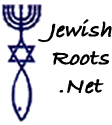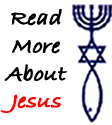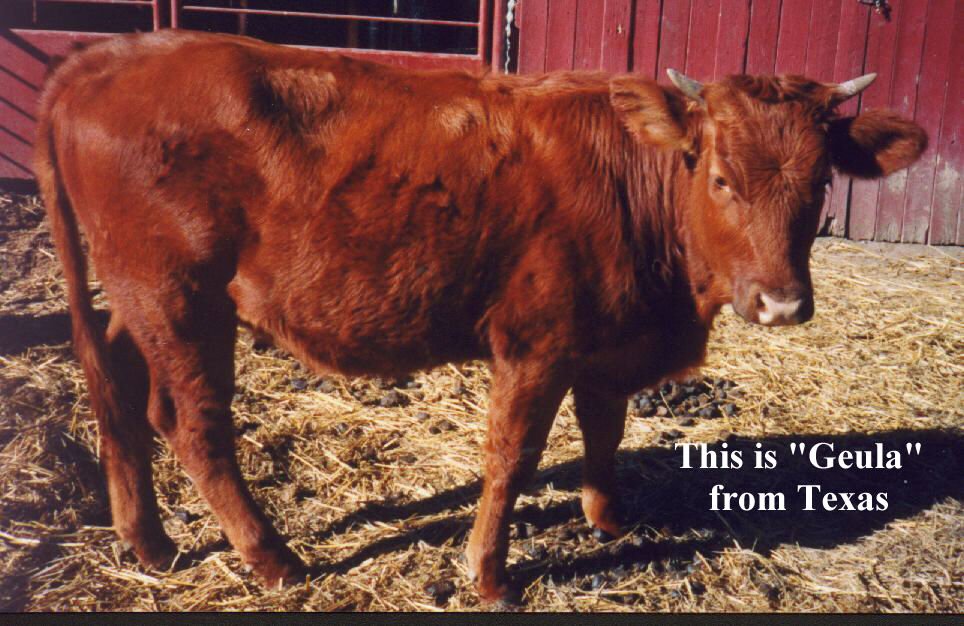







Article Bookmarks |
|
"In Numbers 19, Moses wrote these inspired instructions regarding the mysterious sacrifice of the Red Heifer: "Then the heifer shall be burned in his sight: its hide, its flesh, its blood, and the offal shall be burned. And the priest shall take cedar wood and hyssop and scarlet, and cast them into the midst of the fire burning the heifer. Then the priest shall wash his clothes, he shall bathe in water, and afterward he shall come into the camp; the priest shall be unclean until evening. And the one who burns it shall wash his clothes in water, bathe in water, and shall be unclean until evening. Then a man who is clean shall gather up the ashes of the heifer, and store them outside the camp in a clean place; and they shall be kept for the congregation of the children of Israel for the water of purification; it is purifying from sin. And the one who gathers the ashes of the heifer shall wash his cloths, and be unclean until evening. It shall be a statute forever to the children of Israel and to the stranger who sojourns among them. He who touches the dead body of anyone shall be unclean seven days. He shall purify himself with the water on the third day and on the seventh day; then he will be clean. But if he does not purify himself on the third day and on the seventh day, he will not be clean. Whoever touches the body of anyone who has died, and does not purify himself, defiles the tabernacle of the Lord. That person shall be cut off from Israel. He shall be unclean, because the water of purification was not sprinkled on him; his uncleanness is still on him."
(Numbers 19:5-13)
"In addition to the obvious spiritual significance of the law of the Sacrifice of the Red Heifer we now understand that the water of purification described in Number 19 actually had the ability to destroy germs and infection. The resulting water of purification solution contained ashes from the Red Heifer sacrifice combined with cedar, hyssop and scarlet thread. This water of purification contained "cedar" oil that came from a kind of juniper tree that grew in both Israel and in the Sinai. This cedar oil would irritate the skin, encouraging the person to vigorously rub the solution into their hands. Most importantly, the hyssop tree associated with mint, possibly marjoram, would produce hyssop oil. This hyssop oil is actually a very effective antiseptic and antibacterial agent. Hyssop oil contains 50 percent carvacrol which is an anti fungal and antibacterial agent still used in medicine, according to the book None Of These Diseases."(1)
"When we note that the waters of purification from the Red Heifer Sacrifice were to be used to cleanse someone who had become defiled and unclean due to touching a dead body, we begin to understand that this law was an incredibly effective medical law as well as a spiritual law. The Book of Hebrews reveals that Paul, an educated rabbi, understood that the Red Heifer sacrifice had a practical medical effect as well as its more obvious spiritual element."(1)
Some believe that the significance of the heifer being "red" is symbolic of the red blood of the Messiah Jesus without which there can be no cleansing.
![]() Many feel that the sacrifice of the "red heifer" in some ways reminds us of what Christ had to offer. This red heifer sacrifice points us toward the ultimate sacrifice of Messiah, which is able to accomplish so much more than to "purify the flesh". Remember that the red heifer was to be "without spot" (Num 19:2). Paul teaches about this in the book of Hebrews.
Many feel that the sacrifice of the "red heifer" in some ways reminds us of what Christ had to offer. This red heifer sacrifice points us toward the ultimate sacrifice of Messiah, which is able to accomplish so much more than to "purify the flesh". Remember that the red heifer was to be "without spot" (Num 19:2). Paul teaches about this in the book of Hebrews.
Hebrews 9:13-15 For if the blood of bulls and goats and the ashes of a heifer, sprinkling the unclean, sanctifies for the purifying of the flesh, how much more shall the blood of Christ, who through the eternal Spirit offered Himself without spot to God, cleanse your conscience from dead works to serve the living God? And for this reason He is the Mediator of the new covenant, by means of death, for the redemption of the transgressions under the first covenant, that those who are called may receive the promise of the eternal inheritance.
"The Talmud claims that the Red Heifer sacrifice was the only one of God's commands that King Solomon, the wisest man who ever lived, claimed he did not understand. Although the priest obediently offered the sacrifice as demanded by God, Solomon apparently did not understand why Numbers 19 declared that the priest would be "unclean until evening."
This unusual sacrifice symbolically pointed to Jesus Christ and His sacrifice because our Lord, who was perfectly sinless, judicially took upon Himself the sins of the world so that we who are sinful could become righteous before God. Christ paid the price for our sins.
Just as the Red Heifer was sacrificed "outside the camp" in contrast to all other sacrifices that took place in the Tabernacle or Temple, Jesus was sacrificed outside the city of Jerusalem. In contrast to the normal male animals sacrificed, the Red Heifer was the only female animal the Law commanded to be sacrificed. Significantly, our Lord was betrayed for thirty pieces of silver, the price of a female slave."(1)
Consider this passage from Hebrews 13:10-12
We have an altar, from which those who serve the tabernacle have no right to eat. For the bodies of those animals whose blood is brought into the holy place by the high priest as an offering for sin, are burned outside the camp. Therefore Jesus also, that He might sanctify the people through His own blood, suffered outside the gate. Therefore let us go forth to Him, outside the camp, bearing His reproach.
(Priests were not allowed to eat the offering on the Day of Atonement)
For a deeper reading and better understanding of the biblical role of the red-heifer sacrifice please go to The Temple Institute Web Site.(2)
"Waters from the pool of Siloam were used in the ordinance of the red heifer described in Numbers 19, where Moses was instructed to mix "running" (lit. living ) water with the ashes of the red heifer. The water had to be fresh, able to give life, not stagnant. This mixture of water and ashes was sprinkled on those who had become unclean to purify them. This same Pool of Siloam is also referred to in the New Testament.
It was to this pool that the Lord Jesus sent a man, blind from birth, to wash off the clay that He had applied to the man's eyes. After washing in the pool, the man received his sight (John 9:6-7).
The Pool of Siloam not only held historical significance, but in Jewish tradition it also had a prophetic connotation. First, the Jewish Scriptures speak of a time when, like water poured "upon him that is thirsty, and floods upon the dry ground," God will pour out His Spirit upon all flesh (Isaiah 44:3). Because the waters of Siloam were used to anoint the kings of the house of David, and that anointing was symbolic of the Holy Spirit coming upon an individual (1 Sam. 16:13), the living waters of Siloam became associated with the outpouring of the Holy Spirit.
Second, this outpouring is to take place during the days of the Messiah, the anointed one, a descendant of King David, through whom salvation will come to Israel. Based on Isaiah 12:3, the Pool of Siloam became known as the "well of salvation" and was associated with the messianic age. Thus, to the Jewish people of the Second Temple days, pouring water on the altar at the Feast of Tabernacles was symbolic of the Holy Spirit poured out during the days of the Messiah."(3)
From Moses to the Second Temple there were only Nine Red Heifers:
The Mishna teaches that up until the destruction of the Second Temple, ashes had been prepared from a total of only nine red heifers. The very first red heifer was processed by Moses himself - as the verse states, "... have them bring you a red heifer." The second was done by the prophet Ezra in the days of the First Temple, and during the entire era of the Second Temple only seven more heifers were used for ashes. This was enough to provide for the nation's needs for purification throughout all those years
The names of all the High Priests who prepared those seven heifers during Second Temple times are recorded by the Mishna: Simon the Just and Yochanan each made two; El'yhoeini ben Hakof, Chanamel HaMitzri and Yishmael ben Pi'avi processed one heifer each. Thus, from the time that Moses received the commandment of the red heifer from the Holy One, blessed be He, until the destruction of the Second Temple, purifying ashes had been produced by the hands of these great leaders from a total of nine red heifers.
In recounting this historical record in his commentary to the Mishna, the great Maimonides ends with the enigmatic statement: "... and the tenth red heifer will be accomplished by the king, the Messiah; may he be revealed speedily, Amen, May it be God's will."
With this amazing statement, Maimonides recounts an ancient tradition - that the tenth red heifer is associated with the Messianic era. Does this perhaps mean that the appearance of a red heifer in these waning end times is an indication, a forerunner of the appearance of the Messiah himself, who will officiate at its preparation?
If there has been no red heifer for the past 2,000 years, perhaps it is because the time was not right; Israel was far from being ready. But now... what could it mean for the times we live in, to have the means for purification so close at hand? With the words of Maimonides in mind, we cannot help but wonder and pray: If there are now red heifers... is ours the era that will need them?(2)
June 20, 2014 Red Heifer Born: In January of 2014 a Red Heifer was born in the United States. At the present time (June 2014) it has been inspected and deemed to qualify as an acceptable red heifer for a temple animal sacrifice. The animal is being raised in a manner that is torah observant and therefore will not be disqualified due to its environment. In the past there have been a few other red heifers that have been born but eventually became disqualified for one reason or another such as a few hairs of a different color on the animal besides red. There is a tradition that a Red Heifer will usher in the Messianic age.
For more on this story and to see this Red Heifer Go Here.
http://www.youtube.com/watch?v=byAoFbA6cr8&feature=youtu.be
March 10, 2010 There was an interview with a representative of The Temple Institute, an organization that is active in the process to rebuild the third temple. During this interview he declared that there is now "definitely a kosher red heifer here in Israel."(4)
April 09, 2002 In March of 2002 a red heifer was born in Israel. After the heifer's owner contacted the Temple Institute on April 5th, Rabbi Menachem Makover and Rabbi Chaim Richman traveled to the farm where the heifer is located, to inspect and validate her status. The rabbis found her to be kosher and were satisfied that this heifer could indeed be a candidate to be used in the process of purification of the Temple as described in the book of Numbers, chapter 19. This is an important development towards the rebuilding of the Jewish Temple.
Tradition records that a red heifer in our generation is a herald of the Messianic era. It is certainly an important development towards the rebuilding of the Holy Temple.(5)
There are reports that since this time this red heifer may have been disqualified. It is unconfirmed that there are however acceptable red heifers available outside Israel 10/25/05.
March 18th, 1997 Holy Cow! The birth of a red heifer (cow) in a farm in the religious youth village of Kfar Hasidim (near Haifa) has excited sectors in the religious community. A delegation of some 25 experts, including Rabbis Yisrael Ariel and Yoseph Elboim, visited the farm last week to examine the six-month old cow, and concluded that it is in fact an acceptable red heifer, according to Torah requirements. However, the cow must be at least two years old before it can be used. Until then, the cow will be carefully watched to ensure that nothing occurs to invalidate its status. According to Biblical law, the cow's ashes are used for purification from certain forms of impurity, and is therefore a prerequisite for the renewal of Holy Temple service.(6)
There were reports of a red cow named Melody born in August 1996 that was briefly believed to be "the one." Melody has now been pronounce "unclean" by Israeli rabbis. She grew several white hairs at the tip of her red tail proving she was not really the one. (7)
November 10, 1994 On November 10, 1994 orthodox rabbi Chaim Richman with the Temple Institute was able to observe and certify that Clayed Lotts cattle (red heifer) was acceptable for the purification process and a return to temple sacrifice. There are now Red Heifer's that qualify for Temple service. Rev. Clyde Lott (601-859-2492) with the not for prophet Canaan Land Restoration of Israel, can comment on their current status. Anyone wishing to help support the good cause of land restoration in Israel should contact Clyde.
According to some Rabbinical commentaries, Miriams death (as also Aarons) is narrated immediately following the Red Heifer, in order to teach that as the Red Heifer expiates sins, so to does the death of the righteous.(8)
The high priest was cleansed with the ashes of the red heifer twice during the seven-day period (before the Day Of Atonement) as a precaution.
1). Reference: Jeffrey, Grant R., "The Signature of God", Frontier Research Publications, Inc. (1996), p.152-153
2). The Temple Institute http://www.templeinstitute.org/red_heifer/red_heifer_contents.htm
3). The Feast of Israel by Bruce Scott with The Friends of Israel Gospel Ministry
4). http://en.wikipedia.org/wiki/Red_Heifer
5). Arutz Sheva (IsraelNationalNews.com) April 9th, 2002
6). Arutz Sheva News Service Tuesday, March 18, 1997 / Adar Bet 9, 5757
7). Epicenter by Joel C. Rosenberg p.196
8). The Jewish Roots of Romans by Joseph Shulam p.190
http://vanshardware.com/2010/03/the-temple-institute-the-red-heifer-is-ready-for-the-third-temple/